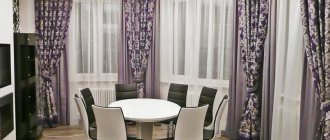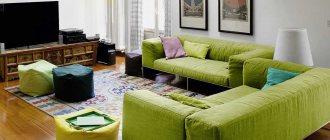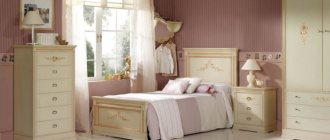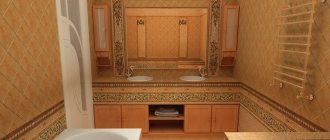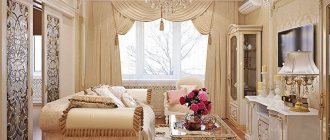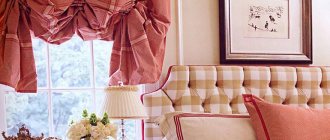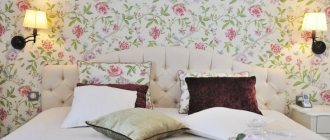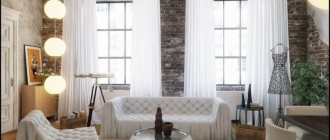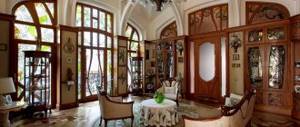Rules and recommendations for selection
Classic curtains will be no less appropriate in a modern interior than in a classic style, but there are other features that need to be taken into account when choosing them.
- You need to select the width of the curtains according to the size of a particular window, otherwise it may look disproportionate.
- Abundant folds and tassels will look good on the wide and tall windows of the hall.
- Dark and deep shades of burgundy, green, and blue will be appropriate only in spacious rooms; for small living rooms and bedrooms, classic-style curtains with tulle and a small lambrequin are suitable.
- Sophistication lies in the right choice of material. The classic style does not accept synthetics; noble fabrics are acceptable: velvet, silk, satin.
Signs of classic curtains are the presence of tulle, sliding curtains with or without a tie, dense fabric material, long panels, and elegant folds.
In modern classics, a combination of textures and types of curtains is acceptable, which does not harm the overall appearance of the interior. For example, classic curtains can be combined with Roman or roller blinds, and airy tulle with blinds.
Classics in curtains
Often, when decorating curtains in a classic style, they are slightly diluted with modern elements. It could be an unusual fabric or some interesting decor. The choice is varied and every year designers create new, interesting options, but their shape does not change over time, they must remain proportional.
If necessary, classic curtains can highlight furniture and decoration. With their help, you can dilute bright colors or make a smooth transition from one shade to another. If you choose them correctly, they will be able to highlight the texture and style of wallpaper, furniture, and decorative elements. Curtains in a classic style offer various design options, the main thing is to adhere to the right color combinations and strict, refined shapes. Features of this style:
Peculiarities:
- Precise, strict proportions.
- Elegant, noble fabrics.
- The right combination of colors.
Types of curtains
Today, the curtain market offers a wide selection of window decoration options, which modern designers successfully use to create a unique interior.
- Classic Roman blinds are a fabric that, using an opening system, forms parallel folds. They can be attached both to the window and to the window opening. They look aesthetically pleasing, are suitable for a small room, and are easy to care for.
- Classic long curtains can fall to the floor or slightly reach it. The curtains are gathered at the sides using decorative ties and complemented by a light curtain that is slightly gathered into waves. Such curtains look luxurious due to the material, but also require special care.
The photo shows an example of a bedroom in a classic style, where the curtains fall from a niche, which makes the window visually larger.
- French curtains create an atmosphere of theater and celebration due to translucent waves on high and wide windows. Stationary French curtains can be used as tulle in addition to curtains, and a curtain with a lifting mechanism can be assembled into a lambrequin.
- You can decorate the space above the window with a lambrequin, thereby making it visually higher. The lambrequin is not adjustable in height; it can be hard or soft, be the same color as the curtains, or become a contrasting accent.
The photo shows an example of a living room with a rigid lambrequin, inside of which a cornice is hidden, which gives an aesthetically complete look.
Classic elements in curtains
If we want to make a room or even a house in a classic design, of course, great attention is paid to the choice of curtains. This is the first thing that catches your eye, because classic curtains are more of an example of art than a curtain from the sun's rays. To enhance the effect, decorative elements and expensive materials were never spared in the design, and they also used the most complex cut imaginable.
Features of classic curtains
- Decorating curtains in a classic way is expensive, but it looks even more expensive. This is the main rule and, perhaps, describes this type of curtains as well as possible.
- The more decorations and decor used for curtains, the less it will be needed when decorating the interior. And for curtains made in a classical manner, nothing is spared, as mentioned above. The unspoken truth of every experienced designer.
- The classics are changing. The style, although remains similar, but time brings its share of changes. Other fabrics are used, more modern and of higher quality, other fastening methods are used, cornices and decorative elements are improved.
- Everything new is well forgotten old. The classics change, but old ideas alternate with new ones in a unique way.
- Restraint in the color palette. For curtains of this type, a maximum of 2-3 colors are used, which are combined with each other. Noble, rich fabrics with or without symmetrical geometric patterns are used.
- Thoughtfulness and attention to detail create the impression of quality, grace, and sophistication.
Lambrequins
This decorative element is considered one of the main attributes of curtains made in the classic version. Soft, lush, formal products will instantly enrich the appearance of curtains.
The color of these elements is chosen to match the curtains, sometimes they may differ by a couple of shades. For added effect, it is decorated with fringe or braid.
Most often they are designed in the form of graceful folds, which are symmetrically located on both sides. Look ideal in halls and living rooms with high ceilings. There you can best convey the richness and luxury of curtains. In addition to them, straight curtains are often used.
There are two types of lambrequins:
- soft
- hard
- combined
Soft ones represent a truly classic style, creating a truly royal interior with their inherent charm and chic.
An example of a soft lambrequin in this photo
Rigid ones are made from non-woven fabric, which is impregnated with special glue. This technology allows you to give the product any shape, completely different sizes and approach each interior project as individually as possible.
A rigid lambrequin is in perfect harmony with straight curtains.
Material
For textile window decoration, mainly noble fabrics are used, such as satin, silk, taffeta, brocade, chenille or velvet. They are able to best reveal the rich atmosphere that classic curtains should create.
In the modern world, in order to stick to the classic version of curtains, it is not at all necessary to sew them from velvet. Any type of high-quality natural fabric, with or without a pattern, is perfect. Eclecticists consider even ordinary straight curtains, which are made in a strict minimalist design and with a minimum of decorative elements, to be classics.
Tulle is made from thin and light materials that easily transmit sunlight and are contrasted with a heavy curtain composition.
Classic satin - grace and splendor.
Jewelry and decor
A distinctive feature of the original classic design style using curtains is the presence of interesting decorative elements. They set the tone for the entire composition, add true rich charm and become the finishing touch to the overall picture.
What can be the classic decorations for curtains?
- magnetic pickups
- textile garters are decorated with fringe
- chain of beads to match the main color scheme
- braided ropes and tassels
- braid
- bugles
Correctly selected decorative elements can advantageously complement classic curtains and have a qualitative impact on the result.
A small example of decor in this photo
Choosing the design and color of curtains
It is important to choose not only the material and type of curtains, but also a color that can visually expand the space, resonate with decorative elements and simply change the perception of the room.
You can choose curtains that will become a bright accent, but will have a similar pattern to the wallpaper or the same pattern as on the upholstered furniture. Also, curtains can be combined in color with upholstered furniture or walls. A win-win option is to choose classic-style curtains to match the color of the kitchen facade, large living room carpet or bedroom bedspread.
Light shades increase the space, deep warm shades reduce it, this must be taken into account when choosing curtains for a small room.
In the classic style, white and cream, beige colors will always be appropriate, which can be diversified with a brown garter or bright edging, fringe, and tassels.
In order to focus attention on the window, you can choose curtains with wide stripes, where 2 or 3 colors are smoothly combined.
Plain curtains will go well with wallpaper with a pattern or design, in this case the interior will not be overloaded. If the wallpaper is plain or has a light texture, then you can choose curtains with patterns or ornaments to match the color of the wallpaper. Classic style curtains with a pattern would be appropriate in a children's room.
Curtains in the interior of a living room in a classic style: color, pattern
Typically, classics are not associated with a riot of colors, prints, or bright designs. Classic is dignity, restraint, a demonstration of taste, a special class and level. When choosing the color of classic curtains, you should take into account the overall interior of the living room. There is only one rule here: the color of the curtains can, as if “echo”, be reflected in other elements of the interior, but in no case duplicate their tone on tone.
The color of the curtains should echo the color scheme of the interior, but in no case repeat it
For example, for walls in milky, beige, yellow colors, you should not choose exactly the same curtains, but shades from the same palette. Otherwise, the curtains will simply blend in with them, which will destroy the entire interior as a whole and the magic of classic curtains in particular. For an interior that is “warm” in color, you should not choose “cold” curtains, and vice versa. Otherwise, the overall harmony will also be disrupted.
You should not choose cold shades of curtains for warm-colored interiors
Very often in a classic interior you can find a combination of light shades of walls and curtains with bright furniture. The main thing is that everything is chosen harmoniously, maintaining logic, taste and level. Curtains for a living room in a classic style can have a pattern, if it is not too pretentious, colorful, or provocative.
Drawings on classic curtains are most often floral patterns
Often this is vertical or horizontal geometry, floral, plant patterns. Plant branches made using the embroidery technique look great on thick curtain fabric. Moreover, the pattern is in the same color palette as the curtain, but has a lighter shade.
If the room is small, you don’t need to choose curtains with a large, eye-catching pattern: it will make it even smaller. If you have a low ceiling, you should choose curtains with horizontal stripes that will make it look higher. If you definitely want curtains with a pattern, you should not choose wallpaper with a floral or any other pattern for the walls. The room will become too colorful and will lose its classic nobility and its own style. You can opt for multi-layer curtain designs, where one layer will be plain and the other with a pattern.
Horizontal stripes on curtains will visually increase the height of the ceiling
Selection of material, fabric characteristics
Classic style curtains are distinguished by the nobility of the fabric, which is widely represented and has a time-tested reputation.
- Silk has high strength, stretches well, does not let the sun's rays through, shimmers beautifully in the light, and drapes well.
- Taffeta is dense to the touch, drapes in wide folds, repels moisture, and lasts a long time with proper care.
- Satin is a durable silk material with a characteristic shine. Dries quickly and does not accumulate static electricity. It is important not to overdry the fabric and wash it at a low temperature.
The photo shows an example of window design in a classic style, where the curtains and lambrequin are made of the same material, and inserts with a floral pattern act as a bright decor.
- Brocade is a silk-based fabric with Lurex embroidered patterns. It is distinguished by its weight and density. Hard material, hard to wrinkle.
- Velvet is a dense material with fine pile of silk fiber. Absorbs moisture, has a long service life, does not attract dust, drapes well, retains heat, and allows air to pass through.
The photo shows an example of how velvet curtains can look light due to color and protect from the sun at the same time.
- Jacquard fabric has a large pattern, density, abrasion resistance, retains color well, and does not stretch. Washable at low temperature, do not wring.
- Chenille fabric has high wear resistance, is pleasant to the touch, retains color well, drapes easily, and is available in a wide selection of composition, color and pattern.
Fabric selection
I sew modern classic curtains from various fabrics. Natural as well as non-natural materials are used for them. So what should you choose? After all, natural fabrics - and so it is clear - will be of higher quality than artificial ones, and they look more luxurious and richer. At the same time, they are susceptible to fading in light, get dirty easily and quickly, and wrinkle. All this practically does not happen in artificial fabrics. They are not able to fade, they are much easier to wash, and they look quite attractive in appearance.
You can see this for yourself by looking at the catalog of photos of curtains for a living room in a classic style. To sew curtains with lambrequins, dense types of fabrics are often used. They are the ones who are responsible for the appearance of the curtains that will result. As for the curtains, they are transparent and transmit light perfectly. That is why they are made from tulle, organza, cambric, and veil.
Types of classic cornices and fastenings to them
An important role is played not only by the material, but also by the appearance of the cornice, as well as the strength of fastening the curtains to it.
- Baguette cornices are best suited to the classic style. The fasteners are not visible behind the bar, which makes the window look complete. The baguette can be plastic with imitation of forging or wood, smooth or carved.
- Tubular cornices can be single-level or two-level, decorated with finials at the edges and made to a specific size.
The photo shows an interior with a wooden tubular cornice, on which there are translucent curtains with a floral print and garters. Here is a classic in simplicity and elegance.
- Profile cornices are convenient for decorating bay windows or corners. Mounts both on the wall and on the ceiling. Made from profile aluminum.
- A forged cornice will attract attention, so curtains should be simple. This cornice is suitable for heavy fabrics. The best method of fastening would be eyelets and rings.
- Wooden cornices can be ceiling, wall, tubular and baguette. The natural shade of wood will fit into the classic interior of any room.
The photo shows a wooden baguette in a classic style design, from which weightless tulle and smooth pastel-colored curtains fall.
Curtains can be attached to the curtain rod in different ways, depending on the weight of the fabric and the style of the room.
- Eyelet fastening is suitable for a modern classic style. This is a fastening method in which rings are sewn into the curtain fabric; it is more suitable for curtains.
- When attached to rings, the fabric is fixed on hooks, and the rings are strung on a tubular cornice.
- Classic curtains with ties look original and varied due to different tying methods (bows and different types of knots). In addition, the color of the ties may differ from the color of the curtains.
- Fabric loops, like eyelets, are threaded onto the cornice. The width of the loops and their number depend on the weight of the curtains. The loops can be on clips, in the form of braids, or sewn to the fabric.
- The drawstring hides the top of the cornice due to the high frill. This fastening is suitable for niche windows, tubular cornices, and cafe curtains. When moving, you will hear a slight rustling of the fabric, and not the knocking of rings on the cornice.
- Curtains with braid look simple and elegant due to the frequent small folds that are formed due to the tightening of the laces to the desired limit. For lush drapery, fabric should be 2 times the size of the window.
Decorative accessories
The beauty of the classic style lies in the luxury and abundance of richness that the details bring. Curtains are decorated with functional accessories, such as:
- Holders made of wood or metal, which are mounted on the wall, hold the shape of the drapery and decorate the curtains. Also, holders can be magnetic, fabric or ribbon.
The photo shows an example of draping curtains and fixing them using holders. The classic mounting height is window sill level.
- The pickups control the light level, are easy to use, and can be changed frequently. They come in the form of hairpins, beads, fabric, ropes. They differ from holders in that they are not attached to the wall.
- Brushes help give the curtains the desired shape and hold it. Also, small tassels can be used to decorate a lambrequin or the edge of a fabric.
- A lambrequin with numerous flaps is suitable for decorating a window in the living room. It may be made of a different material and a contrasting color; in this case, it is important not to overload the room with other decorative elements.
The photo shows an example of how a lambrequin can decorate not only the living room, but also the kitchen.
- In the classic style, fringe decorates the border of the curtains. It can be of different lengths, with beads, bugles and beads, with tassels and weaving.
Browse by room
Bedroom and children's room
For bedrooms in a classic style, delicate shades of light green, blue, and cream are suitable. Here it is recommended to combine curtains with tulle or Roman blinds.
In the photo, the color and pattern of the curtains matches the wallpaper on the accent wall in the bedroom.
Living room
In the living room you can experiment with the color of curtains and their shape. A soft lambrequin will decorate a spacious room in the Baroque style. French curtains can serve as transparent tulle along with thick curtains.
The photo shows the interior of a living room in a house with second light, where light curtains do not draw attention to themselves.
Curtains for the kitchen in a classic style
For the kitchen, you can use light curtains in a classic style, which will let in sunlight and harmonize with the color of the set.
The luxurious dining room will be decorated with beige or olive curtains along with translucent tulle.
Bathroom
Roman, roller or French curtains in a classic style in light blue or white with a pattern are suitable for the bathroom.
When choosing the type and color of curtains in a classic style, it is important to take into account the size of the room, the level of natural light, decorative elements, and proper care of the fabric guarantees a long service life.
Color spectrum
When choosing curtains, consider the overall style of the room. This is what they start from, as well as from the chosen accents in the details. You should also select models so that their color schemes are harmoniously combined with the shades of the interior. If the room in the chosen style is decorated in light colors, the curtains are selected accordingly. But they should not blend in with the color of the material on the walls!
Read: How to sew curtains with your own hands - step-by-step instructions for beginners with photos and descriptions
Decorating living rooms with bright accents is very popular. Walls and ceilings are decorated in light colors, furniture and other decorative elements are decorated in rich colors. Then it would be great to choose bright curtains to decorate the interior.
